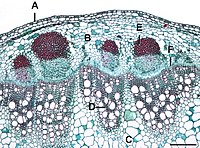
Photo from wikipedia
In conifers, xylogenesis produces during a growing season a very characteristic tree-ring structure: large thin-walled earlywood cells followed by narrow thick-walled latewood cells. Although many factors influence the dynamics of… Click to show full abstract
In conifers, xylogenesis produces during a growing season a very characteristic tree-ring structure: large thin-walled earlywood cells followed by narrow thick-walled latewood cells. Although many factors influence the dynamics of differentiation and the final dimensions of xylem cells, the associated patterns of variation remain very stable from one year to the next. While radial growth is characterised by an S-shaped curve, the widths of xylem differentiation zones exhibit characteristic skewed bell-shaped curves. These elements suggest a strong internal control of xylogenesis. It has long been hypothesised that much of this regulation relies on a morphogenetic gradient of auxin. However, recent modelling works have shown that while this hypothesis could account for the dynamics of stem radial growth and the zonation of the developing xylem, it failed to reproduce the characteristic tree-ring structure. Here we investigated the hypothesis of a regulation by a crosstalk between auxin and a second biochemical signal, using computational morphodynamics. We found that, in conifers, such a crosstalk is sufficient to simulate the characteristic features of wood formation dynamics, as well as the resulting tree-ring structure. In this model, auxin controls cell enlargement rates while another signal (e.g., cytokinin, TDIF) drives cell division and auxin polar transport.
Journal Title: Journal of experimental botany
Year Published: 2020
Link to full text (if available)
Share on Social Media: Sign Up to like & get
recommendations!